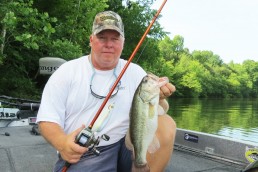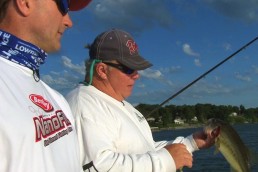Kentucky Lake: Fall’s Often-Overlooked Secret
SHARE THIS POST
With all the hunting activity going on in western Kentucky each fall, fishing is often overlooked. But whether going for bass and crappie as a single activity or as part of a cast-and-blast vacation, Kentucky Lake is a great place to go.
Kentucky Lake enjoys a nationwide reputation as one of the finest crappie and bass lakes anywhere. A dam stretching 8,700 feet across the Tennessee River and rising 216 feet above bedrock forms the lake. Most of the 2,300 miles of shoreline retains a natural state.
Much of the fall fishing success is due to the weather being stable (no passing fronts, as is often the case in spring), the lake level being stable and the same pattern seeming to hold up from week to week. Angling pressure is less in fall, and you can often fish without seeing any other anglers for prolonged periods of time.
The lake is a large impoundment created in 1944 when the Tennessee Valley Authority (TVA) dammed the river for hydroelectric production. Today it has fine fishing habitat. Fish biologists tell us that there is an abundance of cover, baitfish (gizzard shad) and oxygen combined with a rich nutrient level to keep the fish resources plentiful. Locals place fish attractors in the lake and use them effectively to catch crappies.
Many of the attractors are in some of the secondary bays off the main bays. As the water cools, the fish move out of the deep river channels and toward the creek channels. Usually they follow a creek channel into the secondary bays. Right on the edge of the creek channel is a great place to put an attractor.
A popular location of attractors is in 5 to 10 feet of water. They are constructed of a variety of materials. No one knows just how many of them are in the lake or where they are all located. They are made of concrete blocks, old tires, clay flue tiles, stake beds made of old sawmill edging strips, logs or virtually any material.
The theory is that brush structures not only congregate fish but also increase the growth rate of fish. In a lake with a relatively featureless bottom, they provide places for fish to feed, hide and safely rest. Some of the better locations for them are at drop-offs, underwater stream channels or points that extend into the lake.
Are you enjoying this post?
You can be among the first to get the latest info on where to go, what to use and how to use it!
The most popular fishing patterns is the use of a 1/16-ounce jig on a 9-foot pole. Fish it straight up and down in cover. Raising and lowering the offering on an 8-pound test line keeps the bait in front of the fish and down in the cover. This is preferred in vertical cover like stake beds. Some favorite colors of jigs are chartreuse and red. If the water is clear, then switch to clear sparkle jigs or a motor oil color.
With live bait, using minnows on a slip bobber is the preferred rig. It allows you to vary the depth from location to location. The idea is to keep the minnow in front of the fish and to get the minnow down through the cover. Some anglers use braided line to a barrel swivel with a 6- to 8-inch clear monofilament line at the terminal end. This enables the angler to break off when snagged. If one finds an area where the fish are biting aggressively, mark the spot and then back off from it. From a short distance, cast a 1/16-ounce Road Runner into the cover. Using light spinning tackle—a 5 1/2- to 6-foot rod— one can also cast marabou tail jigs and twister tail jigs.
Another popular rig is the Kentucky Rig. Use it in water about 8 to 10 feet deep. This rig is composed of a leader of 25- to 30-pound line. At the terminal end is a 1-ounce bell sinker. Eighteen inches above is tied a 6-inch line with a 2/0 hook. Eighteen inches above that is another 6-inch line with another 2/0 hook. Fish it by tight-lining the rig down into cover where hopefully it will not hang up. Bait the hooks with minnows. It is not impossible to catch two fish at the same time.
One of the factors to fall fishing is the water is low during the winter drawdown. Drawdown allows for the winter accumulation of moisture to not flood the lake. It also might be to avoid dumping too much water downstream. Too much water released in spring could add to flooding problems downstream. In that way, the drawdown is used for flood control.
In any event, in fall the temperatures are cooler and more comfortable. The shoreline foliage is brilliant in its colors beginning about the first week in October. A fall fishing trip to Kentucky lake can be a great time.
Numerous marinas and launch ramps area available all along the shoreline. Most of the marinas are found on the western shoreline, as much of the eastern shoreline is the Land between the Lakes refuge area. Guides and resorts are available throughout the area.
MWO
SHARE THIS POST
Did you enjoy this post?
You can be among the first to get the latest info on where to go, what to use and how to use it!
Don Gasaway
Don Gasaway is a veteran freelance outdoor writer from Marion, Ill. He may also be found at: https://www.facebook.com/DonGasawayWriter and facebook.com/Wandering Angler. Comments are welcome



